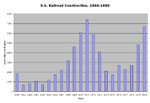| |
Introduction
Railroads also played a key role in the depression that began in 1873 and continued until 1879. The failure of Jay Cooke and Company, the largest investment banking firm in the United States and the principal backer of the Northern Pacific Railroad, signaled the beginning of the deepest and longest depression up to that point in the nation's history. While important, the bank's failure was as much a symptom as a cause of the widespread suffering that soon gripped the nation. The post-war period had witnessed a frenzy of railroad building, and the economic crisis was ultimately rooted in America's railroads. By 1870, the number of miles of rail tracks in the United States had grown to around 50,000 and was increasing by about 6,000 miles (or 12%) per year. About 10% of America's non-farm labor was devoted to expanding the rail network, about half of the production of the nation's metal industry contributed to the related construction boom, and nearly all the business on Wall Street revolved around railroad finance. When railroad owners and financiers realized they had overbuilt, they cut back on construction, which threw millions of people out of work, greatly reduced demand for raw materials, and thrust the nation into depression.
The graph of U.S. railroad construction in the decades following the Civil War provides a sense of how quickly the rate of railroad construction increased and how quickly it declined in the years leading up to the depression of 1873 and the Great Strike of 1877.
Questions to Consider
-
About how many miles of railroad were built per year in the first half of the 1860s?
-
What was the peak year of railroad construction during the period covered in the graph? Approximately how many miles were built during that year?
Document

(click to enlarge)
Source:
U.S. Bureau of the Census, Historical Statistics of the United States: Colonial Times to 1970 (Washington, D.C.: U.S. G.P.O., 1975), 731. Next >>>
<<< Return to Evidence
|